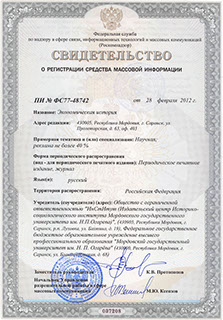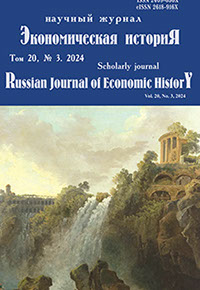Экономическая историЯ
Russian Journal of Economic History
ISSN 2409-630X (Print)
ISSN 2618-916X (Online)
Expert board:
- Scientific Council of RAS on economic history;
- Research and Educational Center «The economic history of Central Russia and the Middle Volga region» of Ogarev Mordovia State University;
- Center of Economic History of Lomonosov Moscow State University
Navigation
Certificate of registration

УДК 332.012:638.19:908
Lidia M. Kolbina, Anastasia S. Osokina
Udmurt FRC UB RAS (Izhevsk, Russia),
e-mail: lidakolbina@yandex.ru
The Historical Perspective of Beekeeping in Udmurtia in the Transformational Processes of Reforms
Abstract
Introduction. The article provides information on the economic performance indicators of apiaries of the Udmurt Republic and apiaries of the collective farm “Russia” of the Mozhginsky district: honey and wax productivity, dynamics of the number of bee colonies, as well as agrometeorological conditions during the privatization period. The purpose of the research is to assess the state of beekeeping in Udmurtia during the period of privatization and to identify patterns of influence of the studied period on the current state of the industry.
Materials and Methods. The work used archival sources and literature on this historical period, reviews of agrometeorological conditions of the Udmurt ASSR. The materials of the funds of the Central State Archive of the Udmurt Republic (CGA UR) are analyzed: P-567 Ministry of Agriculture and Food of the Udmurt Republic, P-1263 State Unitary Enterprise of the Udmurt Republic “Beekeeping of Udmurtia”.
Results. The dynamics of growth and development of the economic efficiency of apiary production is illustrated at the stages: the development of bee families and the production of commercial and gross honey.
Discussion and Conclusion. It was revealed that the number of bee colonies is subject to significant fluctuations over the years. In 1991, apiaries appeared in peasant (farm) farms. In 1992, the number of bee colonies in farms increased from 1.3 thousand to 2.7 thousand in 2000, or more than 2 times. In the agricultural enterprises of the republic, there was a steady tendency to reduce the number of bee colonies from 19.8 thousand in 1992, up to 12.8 thousand in 2000. 3 years after the beginning of economic reforms (since 1992), the state of beekeeping in the collective farm “Russia” deteriorated. The process of reducing bee colonies continued in 1996 and 1998. On average, over 10 years, there were 576 bee colonies on the «Russia» collective farm, which is almost 2 times less. The maximum amount of honey in the collective farm “Russia” was obtained in 1996 and 1998, which is 29 and 37 % higher than in the republic, respectively. The minimum amount was obtained in 1995, which is 28 % lower than the average in Udmurtia.
Keywords: economics, beekeeping, reforms, farms, bee family, agrometeorological conditions, honey and wax productivity.
For citation: Kolbina L. M., Osokina A. S. The Historical Perspective of Beekeeping in Udmurtia in the Transformational Processes of Reforms. Economicheskaya istoriya = Russian Journal of Economic History. 2024; 20(3): 285–297. (In Russ.).
© Ogarev Mordovia State University. History and Sociology Institute, 2017
68, Of. 411, Bolshevistskaya St., 430005, The editorial office of the scholarly journal «Russian Journal of Economic History»
Tel.: (8342) 24-25-90; 27-07-11, Fax: (8342) 24-25-90, E-mail: jurnal-econom-hist@isi.mrsu.ru
Designed by A. Napalkov, Email: napalkov@isi.mrsu.ru

